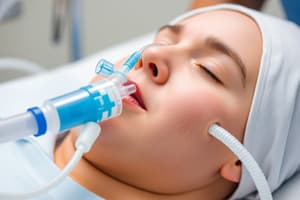Podcast
Questions and Answers
What is important to research when caring for a patient with a tracheostomy?
What is important to research when caring for a patient with a tracheostomy?
The purpose and type of trach the patient has, how to correctly suction a trach.
What must be maintained in the pleural space for the lungs to expand when the chest wall expands?
What must be maintained in the pleural space for the lungs to expand when the chest wall expands?
Negative pressure.
Why might a patient with low oxygen saturation misinterpret stimuli?
Why might a patient with low oxygen saturation misinterpret stimuli?
Lack of oxygen to the brain causes the inability to reason and use normal judgment.
What information do arterial blood gases provide?
What information do arterial blood gases provide?
Which of the following aspects of obtaining an arterial blood gas sample differs from obtaining a venous blood sample? (Select all that apply)
Which of the following aspects of obtaining an arterial blood gas sample differs from obtaining a venous blood sample? (Select all that apply)
How will you know if patient teaching about the incentive spirometer was effective?
How will you know if patient teaching about the incentive spirometer was effective?
Which description is most accurate regarding the mechanics of breathing?
Which description is most accurate regarding the mechanics of breathing?
What initiates contraction of the diaphragm?
What initiates contraction of the diaphragm?
Explain internal and external respirations.
Explain internal and external respirations.
What is the advantage of using a Yankauer suction device or tonsil tip to suction the patient's mouth?
What is the advantage of using a Yankauer suction device or tonsil tip to suction the patient's mouth?
What action will you take if a patient with a trach who is not connected to a ventilator begins to choke when drinking water?
What action will you take if a patient with a trach who is not connected to a ventilator begins to choke when drinking water?
What is the purpose of inserting chest tubes?
What is the purpose of inserting chest tubes?
What is the purpose of the water seal in a chest tube drainage unit?
What is the purpose of the water seal in a chest tube drainage unit?
Which of the following signs and symptoms would indicate your patient is beginning to become hypoxic? (Select all that apply)
Which of the following signs and symptoms would indicate your patient is beginning to become hypoxic? (Select all that apply)
Flashcards are hidden until you start studying
Study Notes
Trachostomy Care
- Understanding the purpose and type of trach is essential before providing care.
- Correct suctioning techniques for tracheostomy patients must be researched and practiced.
Lung Expansion
- Negative pressure in the pleural space is critical for lung expansion during chest wall movement.
Oxygen Saturation and Cognitive Function
- Low oxygen saturation can impair brain function, resulting in misinterpretation of stimuli and poor judgment.
Arterial Blood Gases (ABGs)
- ABGs provide important values including:
- Bicarbonate level
- Partial pressure of oxygen in the blood
- Blood pH
- Partial pressure of carbon dioxide in the blood
Arterial vs. Venous Blood Samples
- Unique aspects of arterial blood gas sampling include:
- Use of a syringe with heparin to prevent clotting.
- Sample collection from an artery rather than a vein.
- Insertion of the needle into a cork post-collection to avoid air contamination.
- Placement of the syringe on ice after sample collection.
Incentive Spirometer Teaching
- Effective patient teaching is demonstrated when the patient correctly uses the spirometer and accurately describes its purpose.
Mechanics of Breathing
- Breathing is an involuntary process driven by the contraction of the diaphragm and intercostal muscles.
Diaphragm Contraction
- The medulla initiates diaphragm contraction through impulses sent to the phrenic nerve.
Internal and External Respiration
- Internal respiration involves the exchange of oxygen and carbon dioxide between the bloodstream and body cells.
- External respiration occurs between the alveoli and lung capillaries.
Yankauer Suction Device Advantage
- The Yankauer suction device or tonsil tip allows continued use despite being bitten down, maintaining its functionality during suctioning.
Tracheostomy Cuff Inflation
- If a tracheostomy patient begins to choke while drinking, it is essential to inflate the cuff if it is not fully inflated to prevent aspiration.
Chest Tube Purpose
- Chest tubes are used to reestablish negative pressure in the pleural space.
Water Seal in Chest Tube Drainage Unit
- The water seal in a chest tube drainage unit serves to maintain negative pressure in the pleural space and to prevent air entry through the chest tube.
Signs of Hypoxia
- Indicators of hypoxia may include changes in respiratory rate, irritability during assistance, confusion regarding location, and complaints of pain above the eyes.
Studying That Suits You
Use AI to generate personalized quizzes and flashcards to suit your learning preferences.




